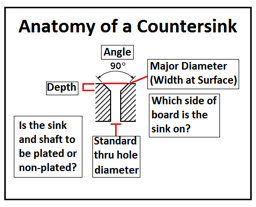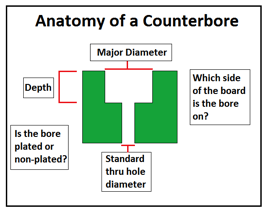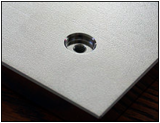Countersink vs. Counterbore
Countersink
A countersink is a cone shaped hole cut into the laminate. It is typically used to allow the tapered head of a screw to sit flush with the top of the laminate. By comparison, a counterbore makes a flat-bottomed hole and its sides are drilled straight down. This is usually used to fit a hex-headed cap or screw.
To accurately drill your countersunk holes, we will need the following information.
- Angle of the drill
- Major Diameter (finished diameter of the hole at the surface)
- Depth the countersink is to be drilled
- On which side of the board is the sink? Top or Bottom?
- The finished diameter of the shaft of the hole
- Is the sink and shaft to be plated or non-plated?

Countersink examples at different angles.

Counterbore
A counterbored hole is typically used when a fastener such as a bolt or cap head screw is required to sit flush with or below the level of a surface.
To fabricate your counterbored holes, we need to know the following information.
- Major Diameter (finished diameter of the hole at the surface)
- Depth the countersink is to be drilled
- On which side of the board is the sink? Top or Bottom?
- The finished diameter of the shaft of the hole
- Is the bore and shaft to be plated or non-plated?
Because the sides of the hole are always parallel, there is no need to specify an angle.


